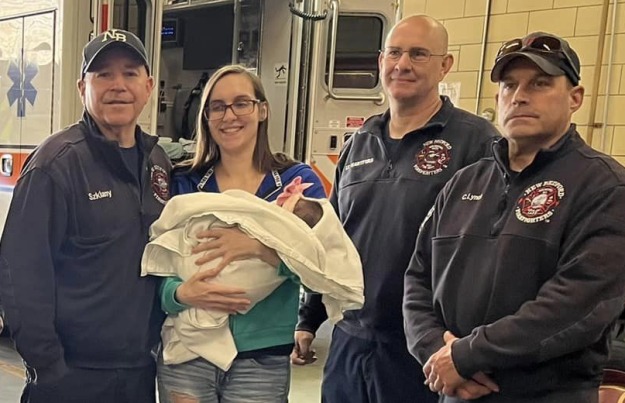Chris Van Buskirk
State House News Service
If supervised drug consumption sites were allowed in Massachusetts, Wrentham resident Lynn Wencus said the child she lost to overdose might still be alive today.
“As long as somebody is breathing, there’s always a chance for recovery,” the Team Sharing member said during a Wednesday rally.
The prospect of legal areas to consume controlled substances has long been a point of contention on Beacon Hill as questions about legality, implementation, and implications for professionals have circulated since the sites were first proposed.
Advocates for the measure gathered in front of the State House Wednesday urging the legislature to pass a bill that would (S 2717) create a 10-year pilot program for at least two sites where clinical professionals would monitor peoples’ use of controlled substances.
Organizers held the rally in honor of Aubree Esters, a longtime advocate for supervised sites. Sen. Julian Cyr, Senate chair of the Mental Health, Substance Abuse and Recovery Committee, said in the weeks before her death, Esters had spoken at length with Cyr’s staff about the legislation.
“This would give us another tool to save lives as the opioid epidemic continues to ravage communities across the commonwealth,” the Truro Democrat said. “This is ever more important in the time of COVID-19 when we have such isolation, when those who use drugs and who are struggling with drug use and addiction are so isolated.”
Under the legislation, the sites must provide hygienic spaces for consumption, on-premise health care professionals to monitor for overdoses, sterile injection supplies, and provide access to naloxone. The Department of Public Health would consider site operators for licensure only after local boards of health sign off on their participation.
Insite Vancouver opened in 2003 and became the first legal supervised drug injection site in North America and cities including Boston, San Francisco, Denver, and Philadelphia have considered opening similar locations.
“Let’s get these safe consumption sites going because we desperately, desperately need them,” Wencus, also a member of non-profit Team Sharing, said.
U.S. Attorney Andrew Lelling has previously threatened to prosecute any effort to create a supervised consumption site program but in 2019 a federal judge in Pennsylvania ruled that the sites would not violate a section of the Controlled Substances Act as government prosecutors once alleged.
The bill is the result of nearly seven months of work from the Harm Reduction Commission, a group that was created after legislators toyed with the idea of creating the sites but instead decided to charge the commission to study the topic.
The Department of Public Health released data in early February showing that a total of 2,023 confirmed and estimated opioid-related overdose deaths occurred in 2019, down from 2,031 in 2018. The number peaked in 2016 at 2,097, according to the data, setting the overdose death rate at 30.5 per 100,000 residents.
Miriam Komaromy, medical director at Boston Medical Center’s Grayken Center for Addiction, recalled a time when naloxone was considered “bizarre and exotic.” Now, she said, the country finds itself in an era when the use of the opioid overdose prevention drug is common.
“Safe consumption sites are the same. They have excellent evidence for their benefit for saving lives, for engaging people in treatment if they’re interested in treatment, for helping to prevent the spread of infectious diseases,” she said at the rally. “There are so many reasons to embrace safe consumption sites and we can’t let the stigma and the politics overwhelm our efforts.”
Two-thirds of the Committee on Mental Health endorsed the bill in mid-May, sending it to Senate Ways and Means where it has remained over the past month.
The House voted Wednesday to extend formal sessions for the rest of 2020, and the Senate seems on board with that idea, raising the possibility that legislators could take up the bill at some point in 2020.
Mary Althoff turns 60 next week and has used IV drugs since she was 14-years-old. She said she would like to see a moment in time when injection drug users have the right and privilege to use in a safe environment.
“I’ve watched a lot of people overdose unnecessarily. I’ve lost a lot of lives unnecessarily. My life could have been lost unnecessarily,” she said. “So please bring it to bear, give these people an opportunity to do what they have the right and privilege to do.”
 New Bedford Guide Your Guide to New Bedford and South Coast, MA
New Bedford Guide Your Guide to New Bedford and South Coast, MA







The term “drug paraphernalia” is widely defined in these statues to include any equipment, product, or material of any kind that is primarily intended for use in introducing controlled substances into the human body. Clearly, hypodermic syringes and needles fall within this domain. Drug paraphernalia statutes ban the manufacture, sale, distribution, or possession of a wide range of devices if the person knows that such devices may be used to introduce illicit substances into the body.
Therefore, drug paraphernalia laws require the presence of criminal intent to supply or use the equipment for an unlawful purpose. Under these statutes, it is not illegal to sell or distribute hypodermic needles and syringes when there is no knowledge that they will be used to inject illicit drugs. A pharmacist who sells hypodermic syringes and needles over the counter believing they will be used for a lawful purpose—for example, by a diabetic to inject insulin—does not commit an offense under drug paraphernalia laws.
The trend toward comprehensive drug paraphernalia laws was advanced by the U.S. Supreme Court’s decision in Village of Hoffman Estates v. Flipside, Hoffman Estates Inc. [455 U.S. 489, rehearing den, 456 U.S. 950 (1982)]. The court held that broadly worded local laws not based on the Model Act were constitutionally valid. Many courts have followed Flipside and upheld statutes with broad definitions of drug paraphernalia [Camile Corp. v. Phares, 705 F.2d 223 (7th Cir. 1983); Garner v. White, 726 F.2d 1274 (8th Cir. 1984); Stoianoff v. Montana , 695 F.2d 1214 (9th Cir. 1983)].
In July 1984, the federal government further limited the supply of sterile injection equipment by enacting an umbrella statute to encompass any activity involving drug paraphernalia crossing interstate lines. The Mail Order Drug paraphernalia Control Act [Anti-Drug Abuse Act of 1986, ss. 1821-1823, PL 99-570, 21 U.S.C. 863 (Use of Postal Service for Sale of Drug Paraphernalia)] originally was designed to prohibit use of the U.S. Postal Service to send equipment to be used for drug injection [Cong. Rec. H665556 (daily ed. September 11, 1986)]. The plain language of the statute also covers “any offer for sale and transportation in interstate or foreign commerce,” or import or export of drug paraphernalia [21 U.S.C. 857(a)]. Furthermore, it contains a similarly broad definition of drug paraphernalia [21 U.S.C. 857(d); the act also authorizes seizure and forfeiture of drug paraphernalia; 21 U.S.C. 857(c)], and has survived constitutional scrutiny [United States v. Main Street Distributing Inc., 700 F. Supp. 655 (E.D.N.Y. 1988)]. The importance of the federal statute is its introduction of federal jurisdiction in an area traditionally reserved for the states.18